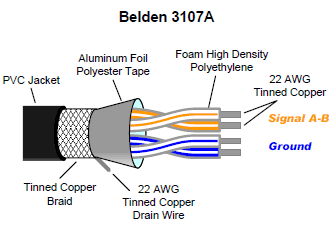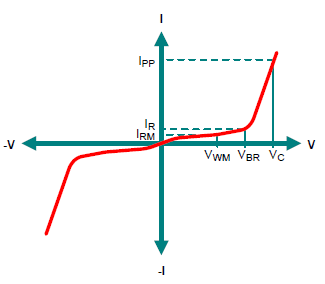RS-485: Transient Protection for Bus Nodes
Thomas Kugelstadt, Senior Applications Engineer, Texas Instruments
Source: http://i.cmpnet.com/industrialcontroldesignline/2009/November/..Nodes.pdf
The substantial cost of industrial network downtime due to malfunctions caused through electrical over-stress makes it necessary to protect network nodes, in particular against electrical transients caused by electrostatic discharge, inductive switching and lightning strikes. The International Electrotechnical Commission (IEC) has, therefore, defined three transient immunity test standards to assure proper circuit operation during and after testing.
This article briefly describes these tests and suggests using an industrial RS-485 cable in combination with low-capacitance transient voltage suppressors as the most efficient way to protect your network.
Family of Transient Immunity Tests
The three IEC standards we will discuss are:
- Electrostatic Discharge (ESD) Immunity (IEC61000-4-2)
- Electrical Fast Transient (EFT) Immunity, or Burst Immunity (IEC61000-4-4)
- Surge Immunity (IEC61000-4-5.
The ESD test simulates the electrostatic discharge of a human onto electronic equipment. The test pulses, generated by an ESD generator, are of short duration (less than 100ns) and have a fast rise time of approximately 1ns. As such the test pulse is of low energy, but can create devastating high currents capable of destroying a transceiver's internal protection circuitry. A minimum ESD test sequence consists of 20 discharges, 10 pulses of positive and 10 of negative polarity, and a one-second pause interval between each pulse.
The Burst test simulates every day's switching transients caused by inductive switching, relay contact bounce, etc. In comparison to the ESD test with single test pulses, a burst generator produces an entire sequence of test pulses, called a burst. Each burst contains approximately 15000 transients. An entire test sequence of six 10s bursts with 10s pause interval in between produces some million pulses within one minute. While a single pulse is short in duration (see Figure 1b), and thus low in energy, the sheer endless bombardment of transients upon a transceiver presents a serious challenge to its internal protection cells.
The Surge test is the most severe test of all as it simulates switching transients caused by lightning. The transients produced by a surge generator are approximately 1000-times longer than ESD or Burst transients. Additionally, the generator's low source impedance allows for high surge currents at high voltages, thus representing a high-energy pulse. Due to its high-energy content, a test sequence commonly consists of five positive and five negative surge pulses with a time interval between pulses of one minute or less.

Figure 1. Examples of an ESD (left), a Burst (middle), and a Surge Pulse (right)
Note: Currents and voltages are normalized. For absolute values refer to the actual standard.
Protecting the Bus Node
Choosing industrial RS-485 cable over low-cost CAT5 or flat-band cable can eliminate the main share of transient energy induced into the bus lines. Cables such as the Belden 3107A (Figure 2) possess a braided shield that significantly reduces noise coupling into the signal conductors. Less noise in the signal wires means lower transient impact on the following protection circuits.

Figure 2. Industrial RS-485 cable with shield and drain wire
The industrial RS-485 cable shown in Figure 2 is ideal for use in single- and half-duplex data links. This allows the use of one signal-pair as bus signal wires, and another signal-pair as ground wire, thus lowering the inductance of the transient current return path. Further benefits are the cable's nominal characteristic impedance of 120 Ohms. This assures impedance matching with the switching characteristics of RS-485 transceivers as well as the addition of a drain wire, which allows for an easy grounding of the cable shield. Note that the shield should only be grounded at one end of the cable, preferably the one closest to the ground reference in a singleground referenced bus.
Figure 3 shows the simplified schematic of a typical RS-485 node circuit with transient voltage suppressor diodes (TVS) for protection. It was not until recently that advancements in process technology enabled the manufacturing of fast, low-capacitance TVS diodes. Previous generations of TVS designs showed response times of several nanoseconds, which often proved too slow for the fast rise times of ESD and burst transients. Moreover, their capacitive loading was in excess of up to 1000 nF per TVS device, which did not allow for efficient protection of a multinode network without dropping the data rate to ridiculously low levels.
The modern, more sophisticated suppressor designs have response times in the lower picoseconds range and, depending on the device topology and power rating, possess capacitances mostly between 10 pF and 100 pF, thus allowing the protection of a single bus node.
In differential data signaling, such as RS-485, typically three transient suppressors are required to resemble an effective protection against real world transients: two TVS devices to protect against common-mode transients occurring between the A line and ground and the B line and ground, and a third TVS to suppress differential transients between the A and the B lines.
A screw terminal, serving as the RS-485 connector, connects the transmission cable to the transceiver (XCVR). Three transient voltage suppressor diodes (TVS) are used to eliminate common-mode transients between A and ground and B and ground, and differential transients between A and B.

Figure 3. RS-485 bus node with transient protection
Figure 4 shows the symmetrical voltage-current (V-I) characteristics of a bidirectional transient voltage suppressor. At lower voltages up to the stand-off voltage, VWM, the transient suppressor presents high impedance to the signal lines and only a few micro-amps leak through the device. In this state the normal operation of the data link has to take place. Therefore, when choosing a TVS for a RS-485 link, its stand-off voltage must be higher than the maximum bus voltage including the ±7V of ground potential difference (GPD) specified in the RS-485 standard, which inevitably requires VWM ≥ 12V.
In a transient event when the bus potential exceeds the TVS break-down voltage, VBR, the device becomes low-impedance conducting high current-to-ground. Its dynamic impedance, however, causes a voltage drop across the device that increases proportionally with rising current. This voltage commonly designated as the clamping voltage, VC, can assume levels of up to 35V, thus clearly exceeding the maxim ratings of a transceiver's bus potentials.

Figure 4. V-I Characteristic of a TVS diode
While transceivers with high ESD ratings can handle this short term over-stress, weaker components will benefit from surge-rated resistors switched in series to the transceiver bus terminals (Figure 3). These resistors with typical values of 10Ω to 20Ω reduce the current towards the transceiver during clamping action, thus minimizing the impact on its ESD cells.
Besides the lethal voltage and current levels, real world transients also present an enormous amount of wideband noise. The noise of an ESD pulse for example has an approximate frequency spectrum from 3 MHz to 3 GHz. Therefore, in addition to transient suppression, noise filtering and high-frequency layout practices are advised to assure a circuit board design that is robust against electromagnetic interference (EMI).
These recommendations will help to accomplish such a design. Plan for transient protection right from the start of your circuit design:
- Use a four–layer printed circuit board with the stacking order - bus signal layer, ground plane, power plane and control signal layer.
- Place the ground plane next to the bus signal layer to establish controlled impedance traces and to provide low-inductance path for return currents.
- Position the TVS diodes as close to the bus connector as possible to prevent transients from infiltrating the board circuitry.
- Place by–pass capacitors (10nF – 100nF) as close as possible to every IC on the board.
- Ground transient suppressors and by-pass capacitors with multiple vias (at least two per terminal) to the ground plane.
- Apply EMI filter on the single-ended side of the transceiver through simple R-C low-pass filters.
Note, because high-frequency currents follow the path of least inductance, most of the recommendations above aim for the diversion of high-frequency noise through low-inductance paths.
Conclusion
Sophisticated transient suppressor diodes allow for efficient protection of every bus node of an RS-485 network. While effective transient protection adds cost to the design initially, it will prevent exorbitant cost in the future due to failures in the field, network downtime, and possible product recalls.
References
- Download application notes for RS-485 interfaces here: www.ti.com/rs485-ca2.
- Download the Interface Selection Guide here: www.ti.com/interface-ca.
- For information on low-capacitance transient voltage suppressors, visit: www.protekdevices.com, www.semtech.com и www.vishay.com.
- For information on industrial RS-485 cable visit www.Beldencable.com.
About the author
Thomas Kugelstadt is a Senior Systems Engineer at Texas Instruments where he is responsible for defining new, high-performance analog products and developing complete system solutions that detect and condition low-level analog signals in industrial systems. During his 20 years with TI, he has been assigned to various international application positions in Europe, Asia and the U.S. Thomas is a Graduate Engineer from the Frankfurt University of Applied Science and can be reached at ti_thomaskugelstadt@list.ti.com.